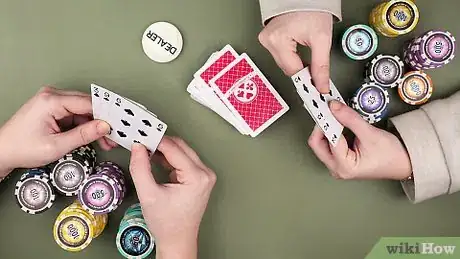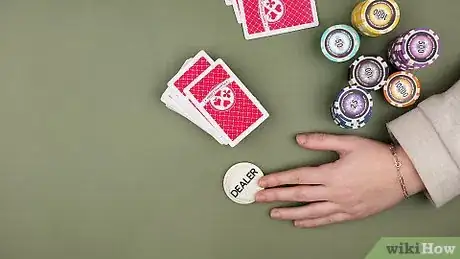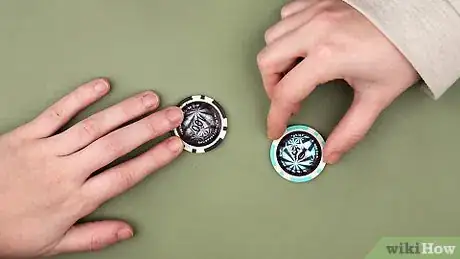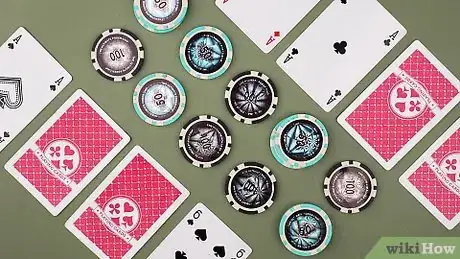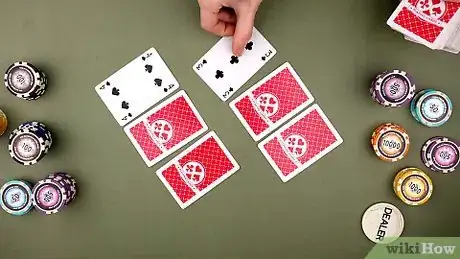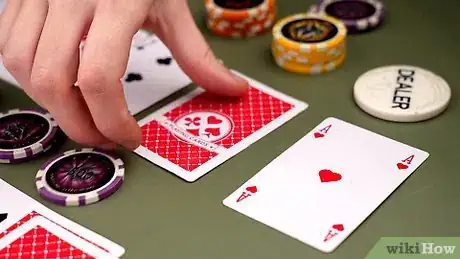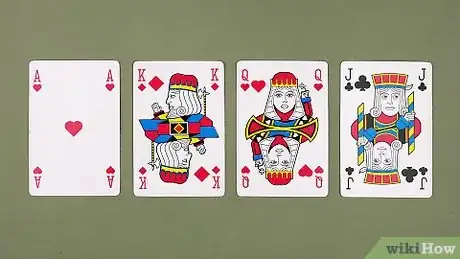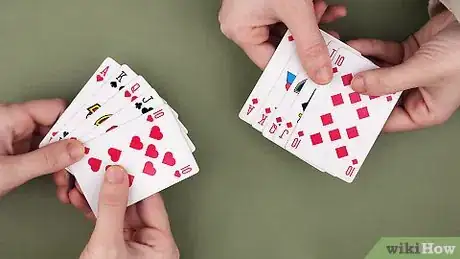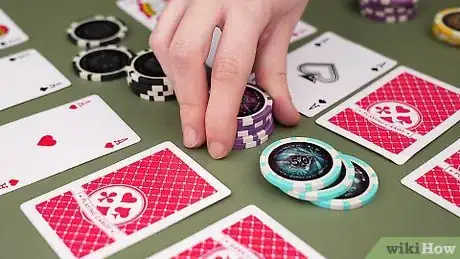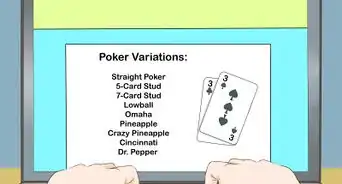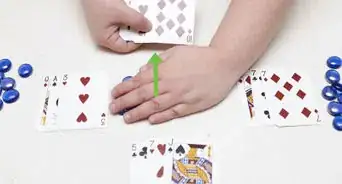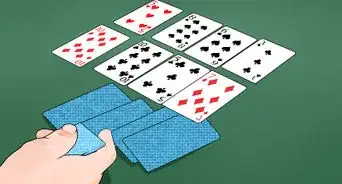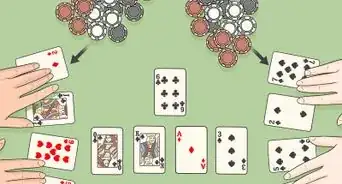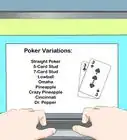This article was co-authored by wikiHow staff writer, Megaera Lorenz, PhD. Megaera Lorenz is an Egyptologist and Writer with over 20 years of experience in public education. In 2017, she graduated with her PhD in Egyptology from The University of Chicago, where she served for several years as a content advisor and program facilitator for the Oriental Institute Museum’s Public Education office. She has also developed and taught Egyptology courses at The University of Chicago and Loyola University Chicago.
There are 7 references cited in this article, which can be found at the bottom of the page.
The wikiHow Video Team also followed the article's instructions and verified that they work.
This article has been viewed 19,259 times.
Learn more...
7 Card Stud is one of many variations of stud poker. There are dozens of poker games, but few are as exciting and popular as 7 Card Stud. Once you know the rules, you can learn the basic strategy of the game after just a few hands. We’ve put together a quick guide to get you started.
Steps
Setup, Ante, and Bring In
-
1Play the game with 2-8 players. While you can play 7 Card Stud with as few as 2 players, you’ll probably have more fun with more people at the table! The maximum number of players is 8, and you’ll be using a standard deck of 52 cards.[1]
- In rare cases, you can run out of cards on the last round of betting if you have 8 players in the game. This will only happen if nobody folds, so it’s pretty rare. If you do end up short on cards, deal the final card face-up on the table as a community card.
-
2Decide among you who the dealer will be. There aren’t any set rules for who deals in 7 Card Stud. Unless you’re playing at a casino with a professional dealer, it’s up to you and your fellow players to choose a dealer. Take a vote or pick the first person who volunteers—however you want to do it![2]
- If you want, you can rotate dealing duties around the table as you play instead of having a single dealer.
Advertisement -
3Set the initial stakes. 7 Card Stud is usually a fixed limit game, meaning that you are only allowed to raise by a limited amount in each betting round. Agree on an initial “small bet” and “big bet” with your fellow players.[3]
- For instance, you might set limits of $2/$4, or $10/$20.
-
4Enter the pot with an ante. To start play, agree on an ante with the other players. Then, have everyone place their ante in the pot. The ante is a small starting bet that everyone has to enter before the first round. In 7 Card Stud, $1 is a common starting ante.[4]
- If you’re playing at a casino, the ante may be determined by house rules.
- The initial ante can also be determined by the fixed limit amount. For instance, in a $2/$4 game with 8 players, $.25 is a typical ante.[5]
Objective and Rules of Betting
-
1Move clockwise around the table as you place your bets. Once the first player in a round has made their bet, have the player to the left of them make the next bet. Each player has the option to fold, call, or raise when it is their turn.[6]
- If you fold, you give up your hand and sit out the rest of the game.
- To call, bet the same amount as the last player.
- To raise, bet a higher amount (e.g., if the bring in was $5, you might raise to $10). If anyone raises, players who already bet must either fold or call the new bet amount.
-
2Ask the player with the best hand to begin each round. The order of play works a little differently in 7 Card Stud than other poker games—there’s no dealer’s chip that works its way around the board and determines who starts each round. Instead, once you’re ready to go to the next round, have the player with the highest exposed cards (or “board”) start the betting action.[7]
- For instance, after you deal the fourth street to start round 2, a player with a pair of kings on the board might have the highest-ranking hand. They would start the next round.
- The only exception is the first round, in which the player with the lowest-ranking door card starts the betting.
-
3Keep your “hole cards” hidden from the other players. Each player will start the game with 2 face-down (or “hole”) cards and 1 face-up (or “show”) card. As the game continues, you’ll get 3 more show cards, then 1 more hole card. Don’t show your hole cards to the other players! Part of the challenge is keeping everyone guessing about what’s in your hand.[8]
- By the end of the game, you’ll have a total of 4 show cards and 3 hole cards.
-
4Build the best possible 5-card hand to win. Much like Texas Hold ‘Em, the objective of 7 Card Stud is to build the highest-ranking hand of 5 cards that you can. Watch your hand carefully and pay attention to the other players’ show cards to gauge your chances of building a strong hand, such as a straight flush or 4 of a kind.[9]
- Remember, you’ll only be able to work with the 7 cards you are dealt. You won’t be working with community cards like you do in Texas Hold ‘Em.
Betting Rounds and Showdown
-
1Play 5 rounds of betting total. A game of 7 Card Stud consists of 5 rounds of betting. For each round, you’ll get a new card, each with a special name. Not all the rounds are played the same way, so pay close attention to the rules for each round.[10]
- Each player gets 3 cards for the first round, but only 1 new card per round after that. The betting limits also change partway through the game.
-
2Deal 3 cards to each player to start, with the third face-up. Once everyone has entered their ante, it’s time to start the first round. Deal 3 cards to each player, passing out the cards 1 at a time. Deal the first 2 cards, known as the “hole cards,” face down. Deal the third card face-up. This is called the “door card.”[11]
- The door card may also be called “third street.”
-
3Have the player with the lowest door card place the first bet. Ask the player with the lowest ranked door card, or “third street,” to make the “bring in” bet. This bet is typically half the amount of the small bet.[12]
- For example, if the stakes are $10/$20, the bring in would be $5. However, the player who places the bring in has the option of raising by betting the entire amount of the small bet (in this case, $10).
-
4Deal a new card to each player to start round 2. Have your chosen dealer pass out a new card to each player, face up. This will be the fourth card in everyone’s hand, called “fourth street.” Ask the player with the highest show card hand to place the next bet.[13]
- For instance, a player with a pair of high-ranking cards, such as 2 queens, might start the betting.
- Each subsequent player has to either match or raise the first bet if they want to stay in the game.
-
5Raise the betting limit to the big bet when you start the third round. At the start of the third round, put down another show card for each player. This card is called “fifth street.” For this round, all the players have to raise if they want to stay in the game. At this point, double the betting limit from what it was at the start.[14]
- For example, if you’re playing a $5/$10 game, the minimum bet to start this round would be $10.
-
6Pass out the final show card to start round 4. For the fourth round, you’ll continue to use the big betting limit. Deal one more face-up card to each player. This card is called “sixth street.”[15]
- Sixth street is the last show card that each player will receive. Everyone should now have 4 show cards.
-
7Start the fifth and final round by dealing the seventh card face down. The final round is also played a little differently from the previous rounds. At this point, deal out a seventh card to each player, but place it face down. This makes it more challenging for the players to determine who’s likely to have the best hand![16]
- The final card is called the “river.”[17]
-
8Reveal your hand after the final bets are called. Once you’ve dealt the final card, the players who are still in the game enter a “showdown.” Make the best possible hand of 5 cards out of the 7 cards you’ve been dealt, then place your bet based on that. In the fifth round, use the same big bet limit that you started using in round 3.[18]
- Once everyone has placed their final bets, reveal the cards in your hand. Whoever has the best hand wins the pot!
Card and Hand Ranks
-
1Learn the values of individual cards. In poker, not all cards are created equal. To understand whether you have a winning hand or not, pay attention to the individual cards as well as groups of cards that work together. In most poker games, including 7 Card Stud:[19]
- The ace is the highest-ranking card, followed by king, queen, and jack.
- The number cards are the lowest-ranking cards, increasing in value from 2-10. However, the ace can also serve as the lowest-ranking card in a straight (A-5).
-
2Familiarize yourself with the ranks of different hands. To do well at 7 Card Stud, you need a good hand—a group of cards that work together. If it helps, write or print out a guide to the different hands that you can refer to as you’re learning the game. In the end, whether you win or lose will be determined by the best 5 cards in your hand, which are ranked as follows, from low to high:[20]
- High card: In a high card hand, you have a single high-ranking card that doesn’t pair or match with anything else in your hand. For instance, if you start the game with a jack, an 8, and a 2, the jack would be the high card.
- Pair: 2 cards of the same rank, such as a pair of 9s, kings, or aces. Not all pairs are worth the same amount—for example, a pair of face cards or aces is worth more than a pair of number cards.
- 2 pair: This is when you have 2 sets of matching pairs (e.g., a pair of 9s and a pair of 4s). There’s no such thing as 3 pair in 7 Card Stud, so you’d want to select the highest 2 pairs if you have 3 pairs in your hand.
- 3 of a kind: 3 cards of the same value, such as 3 4 cards, 3 kings, or 3 aces.
- Straight: 5 cards in a row (e.g., A-5 or 2-6).
- Flush: 5 cards of the same suit (e.g., 5 clubs or 5 diamonds), of any rank.
- Full house: A combination of a pair and 3 of a kind (e.g., 2 queens and 3 5s).
- 4 of a kind: A hand with 4 cards of the same rank (e.g., 4 aces).
- Straight flush: 5 consecutive cards belonging to the same suit (e.g., 2-6 of hearts).
- Royal flush: A flush consisting of a 10, jack, queen, king, and ace of the same suit.
-
3Use the ranks of the card suits to break a tie. Most of the time, all the suits are equal in poker.[21] However, if 2 or more players have identical hands (e.g., if 2 players have a royal flush), then special rules apply. In this situation, the suits are ranked in alphabetical order, from lowest to highest (clubs, diamonds, hearts, spades). The player with the higher-ranking suit would win the round.[22]
- For instance, if 3 players have a high-card hand with a king as their high card, the player with the king of spades would have the winning hand.
General Strategies
-
1Remember which cards other players have. In 7 Card Stud, you’ll do better if you can keep track of which cards are already in play. That includes face-up cards that belonged to players who have folded! If you know what other players already have, that will help you figure out how likely you are to get the hand you need to win (such as a straight, flush, or full house).[23]
- Depending on what’s in your hand, you don’t necessarily have to pay attention to every single card you see. For example, if you start with 3 cards of the same suit, it’s most important to pay attention to other cards of that suit—this will help you determine your chances of completing a flush.
-
2Fold poor hands as quickly as possible. In 7 Card Stud, there’s not much point in staying in the game if you have a weak hand. For example, if you start with only a high card, or with an assortment of cards that you can’t eventually turn into a straight, flush, or other strong hand, then try to fold early.[24]
- Remember, unlike Texas Hold ‘Em, in 7 Card Stud you’re completely relying on what’s in your hand! You won’t be able to build a hand using cards on the board that are available to everyone.[25]
-
3Bet high only if you already have a strong hand. If you already have a strong set of cards in your hand, such as 3 of a kind, that means you’re more likely to win. In these situations, raising the bet is a good idea. It means you increase the size of the pot, and can also encourage players with weaker hands to fold. But, if you’re still building your hand, it’s a better idea to bet conservatively.[26]
- For instance, if you’re building your way up to a straight but haven’t gotten all the cards you need yet, stick to calling other players’ bets and hold off on raising.
-
4Pay attention to how other players are betting. In addition to looking at which cards are in play, you can learn a lot by observing the behavior of your fellow players. Watch how other players react during each round of betting to get a sense of what you are up against.[27]
- For instance, if another player consistently calls instead of raising, it may suggest that they’re trying to build up to a stronger hand (like a straight or flush), but have not completed it yet.
- You might also learn that some players are likely to bluff with weak hands or to fold when someone else starts playing aggressively. You can use these tendencies to your advantage once you notice them.
References
- ↑ http://www.pokerprofessor.com/learn-poker/how-to-play-seven-card-stud
- ↑ https://www.pokerlistings.com/poker-rules-7-card-stud
- ↑ https://www.gamblingsites.org/poker/seven-card-stud/
- ↑ https://www.gamblingsites.org/poker/seven-card-stud/
- ↑ http://www.pokerology.com/lessons/seven-card-stud/
- ↑ https://www.gamblingsites.org/poker/seven-card-stud/
- ↑ http://www.pokerology.com/lessons/seven-card-stud/
- ↑ https://www.pokerlistings.com/poker-rules-7-card-stud
- ↑ https://www.pokerlistings.com/poker-rules-7-card-stud
- ↑ https://www.pokerlistings.com/poker-rules-7-card-stud
- ↑ https://www.gamblingsites.org/poker/seven-card-stud/
- ↑ https://www.gamblingsites.org/poker/seven-card-stud/
- ↑ https://www.pokerlistings.com/poker-rules-7-card-stud
- ↑ https://www.pokerlistings.com/poker-rules-7-card-stud
- ↑ http://www.pokerprofessor.com/learn-poker/how-to-play-seven-card-stud
- ↑ http://www.pokerology.com/lessons/seven-card-stud/
- ↑ https://www.wsop.com/poker-games/seven-card-stud/rules/
- ↑ https://www.pokerlistings.com/poker-rules-7-card-stud
- ↑ https://www.wsop.com/poker-hands/
- ↑ https://www.pokerlistings.com/poker-rules-7-card-stud
- ↑ https://www.wsop.com/poker-hands/
- ↑ http://www.pokerprofessor.com/learn-poker/how-to-play-seven-card-stud
- ↑ https://www.gamblingsites.org/poker/seven-card-stud/
- ↑ https://www.gamblingsites.org/poker/seven-card-stud/
- ↑ http://www.pokerology.com/lessons/seven-card-stud/
- ↑ https://www.gamblingsites.org/poker/seven-card-stud/
- ↑ https://www.pokerlistings.com/strategy/stud/limit-sevencard-stud
